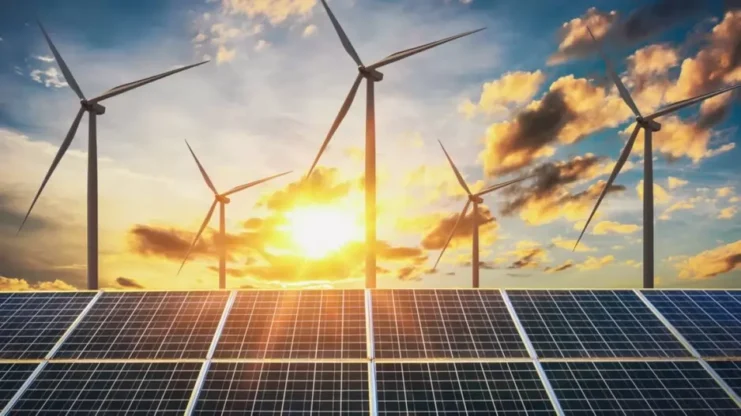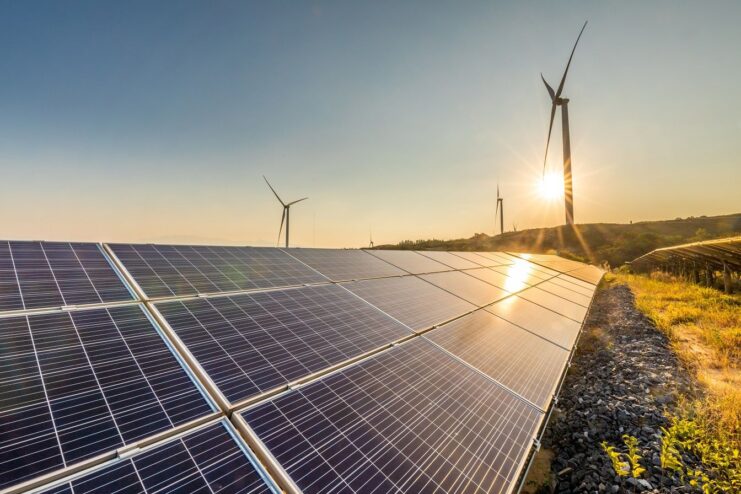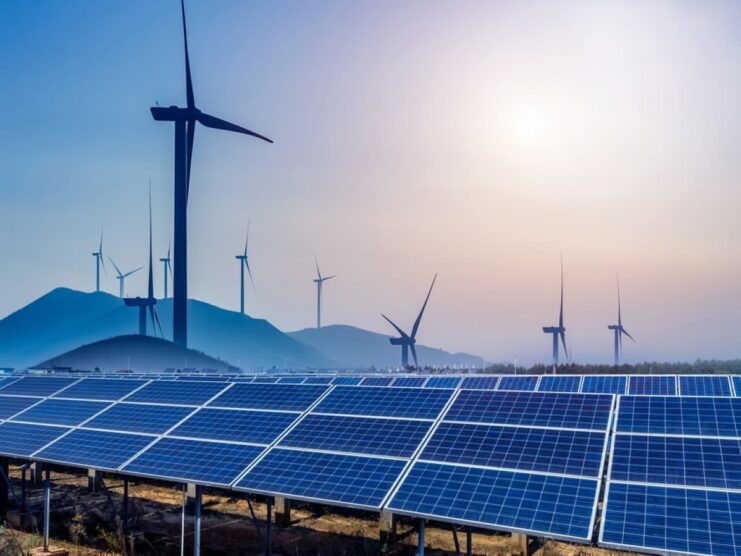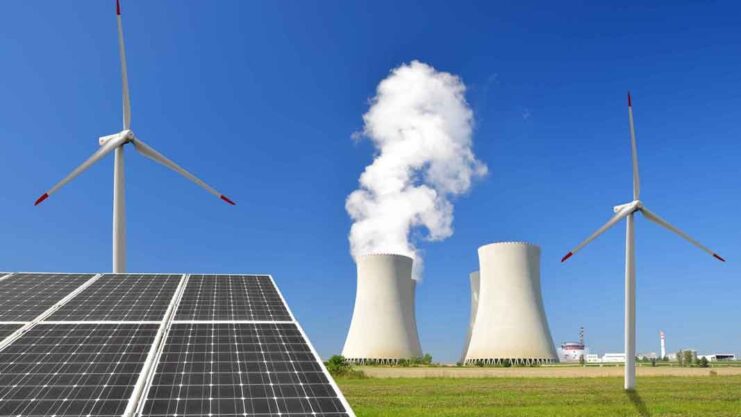Renewable and nonrenewable energies are the two sides of the energy coin, each playing a pivotal role in our modern society. Understanding their differences is not just a matter of academic interest; it is vital for shaping our future energy policies and determining the path of our environmental impact.
The Core Difference

At the heart of the distinction between renewable and nonrenewable energy lies their respective sources. Renewable energy is derived from natural processes that are replenished at a rate that is equal to or faster than the rate at which they are consumed. Solar, wind, hydroelectric, geothermal, and biomass are prime examples of renewable power sources. They are part of Earth’s natural systems, continuously replenished by sunlight, wind, water cycles, geothermal heat, and organic plant matter.
Nonrenewable energy, on the other hand, comes from sources that do not replenish, or do so over a significantly longer timescale than human civilization can feasibly wait. Fossil fuels like coal, oil, and natural gas are the most common examples. These were formed millions of years ago from the remains of ancient plants and animals, and once depleted, they cannot be replaced within a human timeframe. If you want to learn more about the difference between renewable and nonrenewable power sources, check out renovables.blog and stay up to date with the latest trends.
Environmental Impact
The environmental impact of these two power types is starkly different. Renewable power sources generally have a much lower environmental footprint. They produce little to no greenhouse gases or pollutants during operation. Solar panels, for instance, capture sunlight and convert it into electricity without emissions. Wind turbines harness the kinetic energy of wind, again without direct pollution or greenhouse gas emissions.
Nonrenewable sources, particularly fossil fuels, are notorious for their significant environmental impacts. Burning coal, oil, or natural gas releases a substantial amount of carbon dioxide, a major greenhouse gas contributing to climate change. Additionally, the extraction, transportation, and processing of these fuels often result in environmental degradation, such as oil spills, habitat destruction, and water contamination.
Economic Aspects

Economically, renewable and nonrenewable energies tell different stories. The cost of renewable power has been decreasing rapidly, making it increasingly competitive with traditional energy sources. Solar and wind energy, especially, have seen significant drops in price due to technological advancements and economies of scale. Moreover, renewable power projects can offer more predictable and stable pricing, as they are less subject to the geopolitical and market fluctuations that affect fossil fuel prices.
Nonrenewable energy, while historically cheaper, faces increasing costs due to the depletion of easily accessible reserves and the growing expense of extraction technologies. Furthermore, the environmental costs of fossil fuels, often not reflected in their market price, add to their economic burden when considering factors like health care costs related to pollution and climate change mitigation efforts.
Technological Evolution
The technological landscapes of renewable and nonrenewable energies are also evolving differently. Renewable power technologies are rapidly advancing, becoming more efficient, reliable, and cheaper. Innovations in solar cell materials, wind turbine designs, and power storage solutions are continuously improving the feasibility and effectiveness of renewable energy.
In contrast, while there have been technological advancements in the extraction and use of nonrenewable resources, these are often geared towards accessing harder-to-reach reserves, such as deep-sea drilling or fracking. These techniques, while technologically impressive, tend to carry greater environmental risks and higher costs.
Geographic and Infrastructure Considerations

Geographic distribution plays a crucial role in the differing nature of these power types. Renewable energy sources are more evenly distributed around the globe. Sunlight, wind, and water resources are available to some degree in most regions, which allows for a more decentralized and locally adapted approach to energy production.
Nonrenewable resources are not so evenly spread. They are found in specific locations, often leading to geopolitical complexities and dependencies. Countries without fossil fuel reserves are dependent on imports, which can lead to economic and political vulnerabilities.
The Path Towards Sustainability
The sustainability of power sources is perhaps the most critical difference. Renewable energy, by its nature, is sustainable over the long term. It aligns with the principles of sustainable development, which seeks to meet the needs of the present without compromising the ability of future generations to meet their own needs.
Nonrenewable energy, with its finite nature and environmental repercussions, poses significant challenges to sustainability. As these resources deplete, and as the environmental and social costs of their use become increasingly apparent, the shift towards renewable power becomes not just a preference but a necessity for sustainable development.
Integration into the Energy Grid
The integration of renewable and nonrenewable energy sources into the power grid highlights another aspect of their differences. Renewable power sources, particularly solar and wind, are variable – their output depends on the time of day, weather, and seasonal conditions. This variability presents unique challenges in grid management, necessitating advanced technologies for energy storage and grid balancing.
Nonrenewable power sources, on the other hand, typically provide a constant and predictable power output. Fossil fuel-based power plants, such as coal and natural gas, have been the backbone of the electric grid due to their reliability and ability to meet base-load demands. However, this consistency comes with the environmental costs already discussed.
Policy and Regulatory Frameworks

The policy and regulatory landscapes surrounding these energy types are also markedly different. Renewable energy often benefits from policies aimed at reducing greenhouse gas emissions and combating climate change. These policies include tax incentives, subsidies, and mandates for renewable power adoption. Such supportive frameworks are crucial for offsetting the initial costs of renewable energy installations and encouraging research and development.
Impact on Society and Culture
The impact of renewable and nonrenewable energy on society and culture should not be overlooked. Renewable source, with its potential for local-level deployment and lower environmental impact, often enjoys a more positive public perception. The growth of renewable energy can also drive job creation in new sectors, such as solar panel installation or wind turbine maintenance.
In contrast, nonrenewable power industries, such as coal mining and oil drilling, have deeply influenced the cultures and economies of certain regions. The decline of these industries, due to both economic shifts and environmental concerns, can have significant social and cultural impacts, including job losses and changes in community identities.
End Note
In sum, the difference between renewable and nonrenewable energy is multifaceted, encompassing environmental, economic, technological, geographical, and social dimensions. Recognizing and addressing these differences is key to managing the transition to a more sustainable and resilient energy future, one that balances the needs of our planet with those of its inhabitants.












